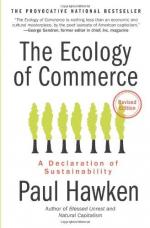|
This section contains 326 words (approx. 1 page at 400 words per page) |

|
Chapter 6, The Size Thing Summary and Analysis
There are two problems in the modern economy: size and scale. These problems function as a barrier to the establishment of taxes and a restorative economy. The distinction between large and small is $100 million in sales. Markets today are global and many companies are multinationals. It is easy for firms to shift money around the globe. Most money in financial markets in the world is used for financing multinational activities and growth. Corporations don't care about habitats or ecosystems. They care about the money they makes.
External costs are not a part of production costs or prices. The more externalization occurs, the more profitable the country is. Internalization of costs can be brought about by a Pigouvian tax. Hawken examines the function of the General Agreement on Tariffs and Trade (GATT). The GATT is a...
(read more from the Chapter 6, The Size Thing Summary)
|
This section contains 326 words (approx. 1 page at 400 words per page) |

|




